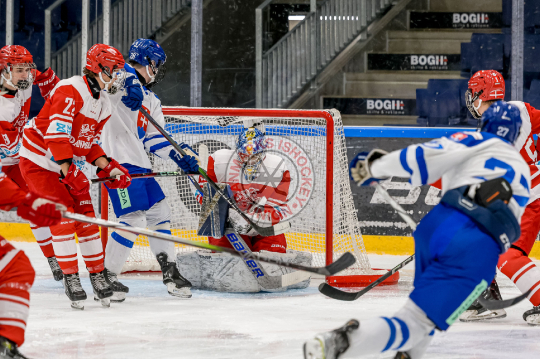The Preview clip on Dansehallerne’s website shows three men in grey jogging suits, each with their head stuck into what looks like a big stuffed pillow. They obviously can’t see through their pillows, and I suspect this is part of the reason why their movements are nothing but a series of bizarre jerks and unmotivated spasms. You feel like you’re watching three grotesquely supersized, blind invertebrates struggling helplessly in a hostile environment. Then, after 72 seconds of futile wriggling, they lie down for what looks like the eternal slumber.
If that’s some metaphor for human existence and what’s eventually to follow, my gut reaction is to say they overdid it in terms of histrionic punch, theatrical effect, or what have you. It’s stark and relentless, a study in existential bleakness. Then I read the press material and came away with a different, more enthusiastic, point of view.
Written, choreographed, and performed by Venezuela’s Luis Lara Malvacias, who in 2003 founded the New York-based theatre collective 3RD CLASS CITIZEN, Two Old Guys is nothing short of the dramatic representation of a key concept in 20th century philosophy. These guys, Malvacias and two other performers, have done their metaphysical homework, and rarely has a philosophical idea – Heidegger’s Dasein (roughly representing human existence) – been wrapped in pillowcases and demanded your attention so insistently.
Heidegger transformed the philosophical scene and became a celebrity overnight when in 1943 he published his magnum opus, Being in Time – which I won’t summarise here. What I will say is that Malvacias, like many others, has found in Heidegger a thinker for whom philosophy meant more than intellectual exercises concerned with artificial problems. Heidegger went straight to the heart of the matter and famously asked: “Why is there something rather than nothing?” He was not everyone’s cup of tea though; his unshakable atheism spurred him to call Christianity nothing but Platonism for the people. Faith, he said, makes you unable to question things, and necessarily shuts you off from truth. One important truth, he claimed, was that human existence was bounded off from death by a horizon of time. And beyond the horizon was not heaven, not nirvana, but just plain nothingness.
It is interesting, but actually not that surprising that Heidegger should appeal to an artist of the stage looking for a new theme and a new angle. After all, the stage, representing the palpable and the essential, is somehow the orchestration of time and space – a medium for the here and now. Which brings me back to Heidegger’s refreshing sentiment that the purpose of philosophy is to intensify life itself. It should, as he put it, kick man out of the lazy attitude of his thinking and throw him back into the harshness of his destiny. This actually sounds like some theatre director’s prep talk before curtain time.
The audio in Two Old Guys is an original score by the award-winning Dutch composer Ivo Bol, a specialist of sound installations whose goal is, quote-unquote, to magnify the atmosphere of lost and found sounds in order to provide a new sound world hospitable to beautiful little details. For some reason that makes me think of the preview’s three visually-impaired, cotton-clad board-treaders stranded in their hostile environment. If there were a God, he’d place them in a new sound world pronto.
As to the final moral of their trials, it’s as yet anybody’s guess. Whatever they do before they drop, however, will challenge the audience in some carefully calibrated way. In part, the audience must recognise that each character is not just another face in the crowd, but rather a curious individual inscribing his own history on a canvas of time. Condemned to be human, mortal, and vulnerable, they carry, like Atlas, their history forward.
I suppose Malvacias would say there are three different approaches to choreographically representing that scenario. You can consider time in terms of historical development, or as a kind of fourth and non-spatial dimension, or, finally and more poetically, as a temporary, transient thing – a slippery, undefinable mystery.
All three conceptions will be engagingly represented and explored in a production charged with dance, acting, design, and installations created by an artist bent on blurring the lines between ‘observer’ and ‘observed’.
Lille Carl, Dansescenen, 20 Pasteursvej, Cph V; starts Thu (16 Aug), ends 18 Aug, daily performances at 20:00; tickets 60-130kr.; duration 85 minutes; 3388 8008, www.dansehallerne.dk, www.laramalvacias.org












